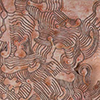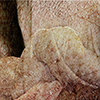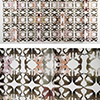Artist Statement
Chronic Fantasia, 2015
2D and 3D works on paper
Chronic Fantasia references the intimate connection between the resting body and the bed covers while additional markings range from a connect-the-dots game to tattoos, freckles, fine tracings of scars and other age-related blemishes. Implicit in this imagery is a Pandora's box of taboos and the work may be seen as brazen trespass into privacy as viewers sense the presence of their own body in a bed, their own skin on display. This is indicative of heavy cultural repulsion. Viewers feel vulnerable as if these pictures are contagious. I suspect that the prints also excite the tactile sense as the desire to touch…what?…a body. They suddenly pull away. I encourage and specifically invite this response hoping the viewer will realize how absurd it is. John Berger reacts differently. In The Shape of a Pocket, he describes his own experience of Frida Kahlo’s work as “double touch”, an awareness of the touch of the tiny brush upon his skin that accompanies his looking at the painting. I recognize this sympathetic impulse as I roll the ballpoint pen across the paper “skin” and synesthetically experience the feel of the pen ball on my skin. And like the aforementioned child, it may feel subversive. This very interior, bodily, approach to artmaking is intimate, but perhaps mistaken as perverse. My actual motivation is to break the cultural norm, to create sensuality that is independent of sexuality, to see the melding of the body with the bed as a common experience and the time that is spent there to be rich: with game playing, cutting and poking, star gazing – the humor and tragedy alike, a fantasia.
The work is also a documentation of slow time, both the extended time required to accommodate physical and mental disabilities, and the time needed for recuperation, especially during chronic illness. I repeat segments, patterns and motifs over and over again in an evocation of this slow time in which action is subtle or nearly non-existent. Frida Kahlo, when confined to a cast for months at a time doodled extensively on it, “drawing through time” as it were, leaving evidence of her time imprisoned in her own body cast. It is this giving up or giving in to the collapse of active time, and strategies for surrendering oneself to physical passivity, that interests me.
— Harriet Sanderson, 2009


